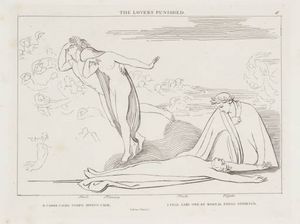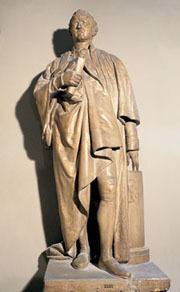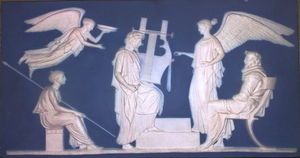John Flaxman
- Short Name:
- Flaxman
- Date of Birth:
- 06 Jul 1755
- Date of Death:
- 07 Dec 1826
- Focus:
- Sculpture
- Mediums:
- Prints, Stone
- Subjects:
- Figure, Scenery
- Art Movement:
- Neoclassicism
- Hometown:
- York, United Kingdom
Introduction
A revered artist in both his home country of Britain and continental Europe during the early 17th and late 18th centuries, John Flaxman was a prolific artist who created works of sculpture, illustrations and designs for the world-famous potter Josiah Wedgwood.
Known today for his legacy as the Royal Academy's first Professor of Sculptor, Flaxman found fame through his illustrations of Homer and Dante's legendary tales. The artist led a relatively quiet family life, marrying his wife Ann at the age of 27 and living in Rome for nine years as he established himself as an artist. Flaxman was a devotee to the Neoclassical movement, using clean lines and simple decoration in all of his works.
John Flaxman Artistic Context
The Neoclassical period occurred during the late 18th and early 19th century in England and continental Europe. It developed in a decorative and artistic sense as a reaction to the over-zealous decoration and often fussy compositions of the Rococo and Baroque styles of the first half of the 18th century.
There was a heavy influence from Ancient Greco-Roman art which was entering England from Italy and Greece through archaeological excavations. Such material was commonly collected by members of the British upper classes or 'Grand Tourists', who travelled around the continent for both pleasure and education.
Neoclassicism as an artistic style consisted of clean lines and uncomplicated designs, whilst sculptures copied the realistic nature of their Roman counterparts, producing beautifully ethereal figures in marble.
John Flaxman Biography
John Flaxman was born in 1755 in York, England. His family moved to London soon after and Flaxman spent a lot of his childhood in his father's plaster-cast workshop. There he honed his talents as a draftsman and learned the techniques of sculpting which his father practiced. The young Flaxman also read many of the classics by Homer and Dante and was exposed for the first time to the ancient art of Greece and Rome commonly found at his father's business.
Flaxman started work as a designer for Josiah Wedgwood in 1775 and produced designs for Wedgwood's iconic Jasperware. Some twelve years later Flaxman travelled to Rome, originally intending to stay for two years to develop his knowledge of ancient art and gain inspiration from the large amounts of archaeological material being excavated across continental Europe. Flaxman remained in Rome for nine years and it was there that he produced his most famous works: his illustrations of Homer's Iliad and Odyssey and later Dante's Divine Comedy.
On his return to England in 1794, Flaxman found a lot of sculptural commissions and created funerary monuments in the round, many of which still stand in St. Paul's Cathedral and Westminster Abbey in London.
Flaxman died in 1826 at the age of 71.
John Flaxman Style and Technique
Flaxman created work in a variety of media and throughout all his Neoclassical taste is evident. The main style points which the artist used to create this Neoclassical effect are listed below.
Composition:
Flaxman using sparse composition, with a great deal of symmetry and balance.
Color:
Producing work in monochrome and marble, Flaxman's complete lack of color for the most part adds an ethereal element to his work and is reminiscent of the works of ancient Greece and Rome.
Perspective:
The almost two-dimensional aspect of the artist's illustrations and the stilted way in which objects far away are portrayed suggest that Flaxman preferred working with objects close to the viewer. Almost like a snapshot in time, with the viewer witnessing the action first hand.
Who or What Influenced John Flaxman
John Flaxman was heavily influenced by a range of factors surrounding his upbringing and life in Britain at the turn of the 19th-century. They include the artistic reaction to the complicated Rococo style which dominated the early 18th century with the influx of Greek and Roman artifacts brought to Britain by the wealthy Grand Tourists of the age.
Greek and Roman Antiques:
Objects coming into Britain from Italy and Greece from archaeological excavations started to become highly collectable pieces for the British upper classes and Flaxman took inspiration from what was known as this "pure" form of art.
In many cases, Flaxman himself admits simply copying the compositions on ancient pottery. Certainly for some of his designs for Wedgwood, they were supposed to be close replicas of one-off pieces which most people could not get hold of. Red and black-figure-ware pottery from classical Greece certainly seem to be the basis of Flaxman's classic illustrations and jasperware designs.
Archaeological collections began to grow through aristocratic collectors at great English country estates, for example, Castle Howard and Petworth. Flaxman's father was heavily involved in the restoration and copying of such pieces due to his casting business and this was a huge inspiration for the young Flaxman. In 1767, 1768 and 1769, Flaxman exhibited models of classical antiques at meetings of the Free Society of Artists.
Travels to Italy:
Flaxman traveled to Italy in 1787 to find artistic inspiration and found several like-minded artists there. Great Neoclassical sculptors of the time were based in the country, such as Antonio Canova. It was in Rome that Flaxman's career as a sculptor really took off, after gaining important commissions for work from patrons across Europe.
Life in Rome also brought Flaxman into closer contact with the Roman archaeological artifacts that were being found in the city.
Legendary tales:
The legendary Greek poet Homer lived around 850 BC and produced some of the most well-known ancient tales in history. Flaxman produced illustrations for both of his best-known works as well as Dante's Divine Comedy, all of which had been recently translated into English by the likes of Alexander Pope.
The Iliad - The story of the Iliad covers the last years of the Trojan War between the Greek armies of Agamemnon and the Trojan armies.
Odyssey - The Odyssey follows the adventures of Odysseus, a Greek warrior and king.
Dante's Divine Comedy - Written between 1308 and 1321 by the Italian writer and poet Dante Alighieri, it is widely thought to be one of the great works of world literature. The poem is split into three sections: Hell, Purgatory and Paradise.
John Flaxman Works
John Flaxman Followers
Flaxman's reputation soared when he returned from Italy in 1794, when he became a well-respected and commercially successful artist in both Britain and the continent. Since then, Flaxman has become known as one of the main sculptures and draftsmen of the Neoclassical movement and although some critics find his work a little cold or without feeling, no one can deny his influence on illustrators and sculptors since then.
Minimalism:
20th-century Minimalism, mainly a school of sculpture, shares many of the same principals that were first introduced to the art world by Flaxman and his contemporaries.
The clean lines of his drafts and the lack of shading or extra narrative echo the work of Minimalist artists and focus the viewer attention on the main themes of the scene. His sculpture, likewise, has a simple nature far removed from the fuss and complicated compositions before the Neoclassical period.
Ingres:
Sarah Symmons suggested in 1971 that the Neoclassical painter Jean-Auguste-Dominique Ingres (1780-1867), may have drawn some influences from Flaxman in his own works.
Ingres was commissioned to paint one of the ceilings of a gallery in The Louvre, Paris. His final design, Apotheosis of Homer, shows Homer surrounded by the great artists of the age. Not only does this painting share the subject of one of Flaxman's earlier designs for Wedgwood, but it is known that on an early drawing of the piece Ingres drew Flaxman into the bottom right-hand side of the picture and that the friezes on the temple in the background are copies of Flaxman's line drawings of the Iliad.
Antonio Canova:
The Italian sculptor Antonio Canova was an avid fan of Flaxman, and was one of the few contemporary sculptors who could rival Flaxman's work in the Neoclassical style. So impressed was Canova when the two artists met in Rome around 1788 that he supplied Flaxman's name to some of his patrons.
One patron in particular was Frederick Hervey, Earl of Bristol, who commissioned Flaxman to create a sculpture for his mansion at Ickworth, Surrey. Flaxman duly created one of his first 'academic groups,' The Fury of Athamas.
It is widely thought that Flaxman and Canova, who remained good friends until the latter's death, shared their thoughts and ideas on composition and theme. Given this, it's easy to see the similarities between their work when looking at the form and style of Flaxman's Athamas and Canova's Hercules and Lichas.
John Flaxman Critical Reception
Flaxman was a very successful artist in his own lifetime and his work, if not his name, is still revered around the world today. Many of the artist's contemporaries, such as Antonio Canova and Henry Fuseli, were admirers, and throughout the 19th century people still took inspiration from his sculptures, drawings, and ceramic designs. Even today sculptures such as Monument to William Murray in Westminster abbey, London, is still in its original setting and Flaxman's designs for Wedgwood fetch high prices at auction.
Contemporary Reception:
Canova:
Antonio Canova, whom Flaxman met in Rome in 1788, was an avid fan of his work. Often recommending Flaxman to patrons and friends, the two remained close until Canova died in 1822.
Schlegel:
The writer A. W. von Schlegel was a friend of Flaxman's and obviously admired his work as a draftsman. "... it seems magical that so much soul can live in so few and such delicate strokes."
Goethe:
Johann Wolfgang von Goethe, a key figure in German literature, was introduced to Flaxman's work through his friend Schlegel. He wasn't, however, as impressed as Schlegel was, and in a rather contemptuous tone described the artist as "the idol of all dilettanti."
Modern Day Reception:
Flaxman is generally well-received for his sculpture in modern times; it is for his illustrations that he has received some criticism. Possibly because Neoclassicism is no longer as fashionable as it was in Flaxman's day, some critics find his work cold and inhuman.
- "His engravings have cheese-wire outlines, and no shading or cross-hatching... limpid but rather prim simplicity"
- "Reduced to pure contours, the visible world in general, and the relics of antiquity in particular, seemed to assume an unearthly, ethereal character, detached from the material qualities of color, weight and surface texture."
- "These remarks have a clear thrust. Pure, flat, schematic, geometric, unearthly, ethereal, prim, puritanical: Flaxman's art denies us the solid, pulsing flesh. It's bodyless, heartless, sexless, weak, empty, inert."
David Bindman disagrees with these critics, saying: "These critics don't see where the power of this art lies - its physical power. Their basic mistake is to assume that Flaxman has a style, which he applies uniformly. They suggest that he reduces everything to pure contour. But if contour means the kind of line you would trace round the very outside edge of a body or object, then evidently that's not true."
John Flaxman Bibliography
To read more about John Flaxman's life and works please refer to the recommended reading list below.
• Bindman, David. John Flaxman, 1979
• Constable, W. G. John Flaxman - 1755-1826, 2006
• Simpson, Ian. Anatomy of Humans: Including Works by Leonardo Da Vinci, John Flaxman, Henry Gray and Others, 1991
• Irwin, David G. John Flaxman, 1755-1826: sculptor, illustrator, designer, 1979
• Hayley, William. An Essay on Sculpture: In A Series Of Epistles To John Flaxman, 2007



























